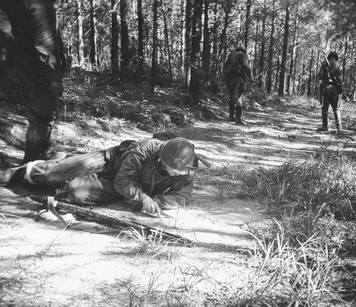
SAPPERS
(This page contain information specific to the Sapper Section. For information on the base impression CLICK HERE.)
Welcome to the Red Guard's Sapper section!
In the Red Army, Sappers performed three basic roles:
1. Laying and clearing landmines.
2. Creating and breaching obstacles. In addition to minefields, this includes barbed wire entanglements, anti-tank and anti-personal obstacles, entrenchments, and fixed fortifications.
3. Assault troops. After punching a hole in the enemy defenses, Sappers typically functioned as assault infantry. With their body armor, explosives, and submachineguns, they were a formidable force.
Sappers were also general engineers and could assist with the construction of fortifications, bridging operations, and general demolition.
Uniform and equipment
Sappers wore the standard infantry uniform described on our base impression guidelines page. However, they also had some specialist equipment that set them apart from other units.
Camouflage suits - When operating in the field, sappers often wore one of the standard pattern Soviet camo suits. Our sappers generally wear the "amoeba" pattern but this is not a requirement.
Body armor - The SN-42 armor was often worn while working with explosives and participating in breaching actions. It provided some protection against lower velocity projectiles, fragments, and shrapnel.
NR-40 knife - Often called the "scout" knife, they NR-40 was also frequently seen in the hands of sappers.
Engineer bags - Used for carrying mines and incendiary bottles, this padded bag was a standard piece of equipment in sapper units. Other equipment since as mine-marking flags and wire cutters could be strapped to the bottom.
Implements - Long-handled shovels, wire cutters, mine probes, and other specialist equipment helped sappers execute their assigned duties in the field.
PLEASE NOTE - This is a new impression for us and research is ongoing.
(This page contain information specific to the Sapper Section. For information on the base impression CLICK HERE.)
Welcome to the Red Guard's Sapper section!
In the Red Army, Sappers performed three basic roles:
1. Laying and clearing landmines.
2. Creating and breaching obstacles. In addition to minefields, this includes barbed wire entanglements, anti-tank and anti-personal obstacles, entrenchments, and fixed fortifications.
3. Assault troops. After punching a hole in the enemy defenses, Sappers typically functioned as assault infantry. With their body armor, explosives, and submachineguns, they were a formidable force.
Sappers were also general engineers and could assist with the construction of fortifications, bridging operations, and general demolition.
Uniform and equipment
Sappers wore the standard infantry uniform described on our base impression guidelines page. However, they also had some specialist equipment that set them apart from other units.
Camouflage suits - When operating in the field, sappers often wore one of the standard pattern Soviet camo suits. Our sappers generally wear the "amoeba" pattern but this is not a requirement.
Body armor - The SN-42 armor was often worn while working with explosives and participating in breaching actions. It provided some protection against lower velocity projectiles, fragments, and shrapnel.
NR-40 knife - Often called the "scout" knife, they NR-40 was also frequently seen in the hands of sappers.
Engineer bags - Used for carrying mines and incendiary bottles, this padded bag was a standard piece of equipment in sapper units. Other equipment since as mine-marking flags and wire cutters could be strapped to the bottom.
Implements - Long-handled shovels, wire cutters, mine probes, and other specialist equipment helped sappers execute their assigned duties in the field.
PLEASE NOTE - This is a new impression for us and research is ongoing.
